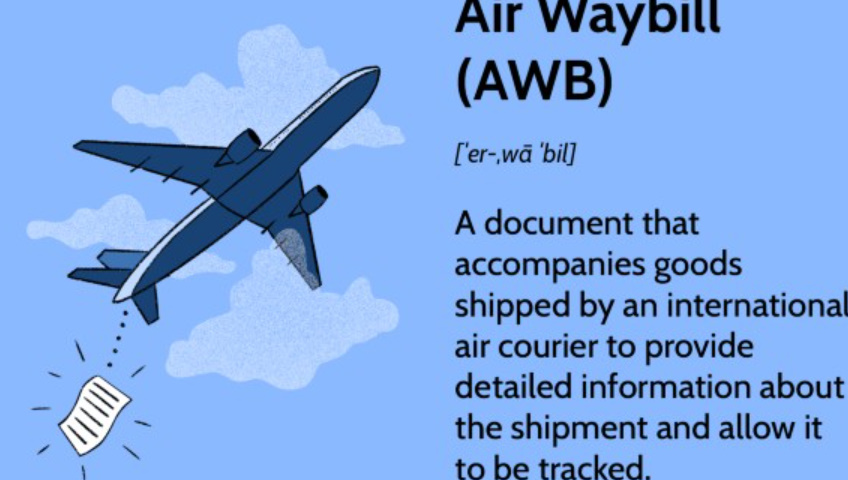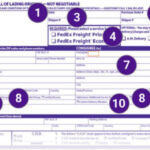1. Introduction to AWB Tracking
Air Waybill (AWB) tracking is an essential process in the logistics and air freight industry. The Air Waybill, often referred to as an AWB, serves as a key document in international air cargo transport. It acts as a contract of carriage, a receipt of goods, and a document of title, providing a detailed overview of the shipment. With the advent of global trade, tracking the status of shipments through AWBs has become a critical function, offering transparency and ensuring timely delivery.
AWB tracking allows both the shipper and the consignee to monitor the status of their goods as they move through various stages of the transportation process. This is not only crucial for maintaining supply chain efficiency but also for ensuring that all parties are informed of any delays, mishaps, or issues that may arise during transit.
2. The Structure of an Air Waybill
An Air Waybill is a standardized document that contains specific details about a shipment. Understanding the structure of an AWB is fundamental to effective tracking.
Key Components of an AWB:
- AWB Number: This unique identifier is crucial for tracking purposes.
- Shipper and Consignee Information: Details about the sender and recipient.
- Flight Information: Data on the flights that will carry the cargo.
- Cargo Description: Details about the goods being shipped, including weight, dimensions, and nature of the cargo.
- Freight Charges: Information on the cost of transportation and who is responsible for payment.
AWB Number Explained: The AWB number is a 11-digit code that uniquely identifies a shipment. The first three digits represent the airline code, and the remaining eight digits are the shipment’s serial number. This number is the key to tracking your shipment throughout its journey.
The Legal Role of an AWB in Shipping: Beyond tracking, the AWB serves as a contract between the shipper and the carrier. It outlines the terms of carriage, including the carrier’s responsibility and liability limits.
3. Types of Air Waybills
There are several types of AWBs, each serving different purposes within the logistics chain.
Master Air Waybill (MAWB) vs. House Air Waybill (HAWB):
- Master AWB (MAWB): Issued by the main carrier or the airline, the MAWB covers the entire shipment from origin to destination.
- House AWB (HAWB): Issued by a freight forwarder, the HAWB often covers smaller shipments within a larger consolidated shipment under the MAWB.
Electronic Air Waybill (e-AWB): With the advancement of digital technology, the traditional paper AWB is being replaced by the electronic Air Waybill (e-AWB). The e-AWB is not only more environmentally friendly but also enhances the efficiency of the tracking process by reducing paperwork and speeding up data exchange.
4. How AWB Tracking Works
Tracking a shipment using an AWB number is a straightforward process, thanks to modern tracking systems.
The AWB Number as a Tracking Tool: The AWB number is entered into an airline’s or a third-party logistics provider’s tracking system to retrieve real-time updates about the shipment’s status. These updates include information on when the cargo was loaded, its location at various points in transit, and the estimated time of arrival at its final destination.
The AWB Tracking Process: Once a shipment is handed over to the airline, the AWB number is scanned into the tracking system. As the cargo moves through different checkpoints – from loading onto the plane, to unloading at the destination, to clearing customs – each step is recorded and updated in the tracking system. This allows both the shipper and the consignee to monitor the progress of the shipment.
Systems and Technologies Behind AWB Tracking: AWB tracking is supported by sophisticated IT systems that integrate data from various sources, including airlines, airports, and customs authorities. These systems ensure that the tracking information is accurate and up-to-date.
5. Steps to Track Your Shipment Using AWB
Tracking your shipment using the AWB number is a simple process, but it requires a basic understanding of where to find the information and how to interpret it.
Locating the AWB Number: The AWB number is typically found on the shipping documents provided by the carrier or freight forwarder. It is also often sent via email or made available on the shipper’s online portal.
Using Airline and Third-Party Tracking Platforms: Most airlines offer online tracking platforms where you can enter the AWB number to get the latest information on your shipment. Additionally, many third-party logistics providers offer similar tracking services that aggregate information from multiple carriers.
Interpreting AWB Tracking Information: When tracking a shipment, you’ll encounter various status updates such as “Departed,” “In Transit,” “Customs Cleared,” and “Delivered.” Understanding these statuses is crucial to accurately gauging the progress of your shipment and anticipating any potential delays.
6. Benefits of AWB Tracking
AWB tracking offers several advantages that make it indispensable in modern logistics.
Real-Time Shipment Updates: One of the primary benefits of AWB tracking is the ability to receive real-time updates. This allows all stakeholders to stay informed about the exact status of the shipment and make necessary adjustments to their operations.
Enhanced Transparency in Supply Chains: AWB tracking provides transparency across the supply chain, ensuring that everyone involved, from the shipper to the consignee, has access to accurate and timely information. This transparency is essential for maintaining trust and ensuring smooth operations.
Improved Customer Satisfaction: By offering precise tracking information, businesses can keep their customers informed, reducing anxiety and increasing satisfaction. This is particularly important for high-value or time-sensitive shipments where the cost of delays can be significant.
7. Challenges in AWB Tracking
Despite its many benefits, AWB tracking is not without its challenges.
Common Issues with AWB Tracking: Some of the common issues include delays in updates, incorrect status information, and technical glitches in tracking systems. These issues can lead to confusion and frustration for shippers and consignees alike.
How to Address AWB Tracking Discrepancies: When discrepancies arise, it’s essential to communicate with the carrier or freight forwarder promptly. They can provide clarification or take corrective actions if there are errors in the tracking information.
The Impact of Delayed Tracking Updates: Delayed updates can have a ripple effect across the supply chain, leading to misaligned schedules, increased costs, and strained relationships between shippers and consignees. Therefore, it’s crucial to have contingency plans in place to mitigate the impact of such delays.
8. AWB Tracking and International Shipping
AWB tracking is particularly critical in international shipping, where multiple parties and countries are involved.
Importance in Cross-Border Logistics: In international shipping, AWB tracking helps navigate the complexities of cross-border logistics, including varying regulations, customs procedures, and potential language barriers.
Compliance with International Shipping Regulations: AWBs must comply with international shipping regulations, which can vary from country to country. Accurate tracking ensures that all necessary documentation is in place and that shipments meet these regulatory requirements.
Customs and AWB Tracking: Customs authorities use the AWB as part of their documentation review process. Real-time tracking can help ensure that customs procedures are completed promptly, reducing the risk of delays.
9. Role of AWB in the Air Cargo Industry
The Air Waybill plays a pivotal role in the air cargo industry, facilitating the movement of goods across the globe.
How AWBs Facilitate Global Trade: By serving as both a contract and a tracking document, the AWB enables smooth transactions between international trading partners. It provides the legal framework and the logistical information needed to ensure that goods move efficiently from one country to another.
AWB Tracking in Freight Forwarding: Freight forwarders rely heavily on AWB tracking to manage complex logistics operations. By consolidating shipments and managing multiple carriers, freight forwarders use AWB tracking to optimize routing and ensure timely delivery.
Case Studies of AWB in Action: Numerous case studies highlight the effectiveness of AWB tracking in improving operational efficiency, reducing costs, and enhancing customer satisfaction in the air cargo industry.
10. The Future of AWB Tracking
As technology continues to evolve, so too does the future of AWB tracking.
Innovations in AWB Technology: Emerging technologies such as blockchain, IoT, and AI are set to revolutionize AWB tracking, making it more secure, efficient, and transparent.
The Shift Toward e-AWB: The industry is gradually moving towards the adoption of the electronic Air Waybill (e-AWB). This shift is driven by the need for more sustainable and efficient documentation processes.
Predictive Tracking and AI Integration: Future AWB tracking systems may incorporate AI to predict potential delays or disruptions, allowing shippers and consignees to take proactive measures to mitigate risks.
11. Differences Between AWB and Other Tracking Systems
While AWB tracking is specific to air cargo, it’s essential to understand how it compares to other tracking systems.
AWB vs. Ocean Bill of Lading (OBL): The Ocean Bill of Lading (OBL) serves a similar function in sea freight as the AWB does in air freight. However, there are differences in documentation requirements, legal implications, and tracking capabilities.
AWB vs. Courier Tracking: Courier tracking systems, used by companies like FedEx and DHL, are typically more consumer-oriented and offer more frequent updates. AWB tracking, on the other hand, is designed for larger, commercial shipments and may provide less granular detail.
How AWB Complements Other Tracking Methods: For companies that use multiple modes of transport, AWB tracking can be integrated with other tracking systems to provide a comprehensive view of the entire supply chain.
12. Security Concerns with AWB Tracking
Security is a significant concern in AWB tracking, particularly as more data moves online.
Protecting Sensitive Information: AWBs contain sensitive information, including details about the shipper, consignee, and cargo. Ensuring this information is protected from unauthorized access is paramount.
Cybersecurity Measures in AWB Systems: To mitigate the risk of data breaches, AWB tracking systems must incorporate robust cybersecurity measures, including encryption, firewalls, and secure access protocols.
Handling Data Breaches and Fraudulent AWBs: In the event of a data breach, it’s crucial to have protocols in place for quick response and mitigation. Additionally, measures must be taken to detect and prevent the use of fraudulent AWBs, which can lead to significant financial losses and legal issues.
13. How Airlines and Freight Forwarders Use AWB Tracking
Airlines and freight forwarders are the primary users of AWB tracking systems.
Role in Inventory Management: AWB tracking plays a crucial role in inventory management, helping airlines and freight forwarders keep track of their cargo and ensure that it is delivered on time.
Streamlining Operations with AWB Tracking: By providing real-time data on shipment status, AWB tracking helps streamline operations, reduce delays, and optimize routing decisions.
Partnering with Third-Party Logistics Providers: Many airlines and freight forwarders partner with third-party logistics providers to enhance their AWB tracking capabilities. These partnerships allow for more sophisticated tracking solutions that integrate multiple data sources.
14. AWB Tracking for Businesses
Businesses across various industries rely on AWB tracking to manage their supply chains effectively.
Integrating AWB Tracking into Supply Chain Management: Integrating AWB tracking into a company’s supply chain management system can provide valuable insights into shipment performance, helping businesses optimize their logistics operations.
Leveraging AWB Data for Business Intelligence: AWB tracking data can be analyzed to identify trends, predict future shipment needs, and improve overall supply chain efficiency.
Case Studies of Businesses Using AWB Tracking Effectively: Many businesses have successfully leveraged AWB tracking to reduce costs, improve customer satisfaction, and gain a competitive edge in their markets.
15. Frequently Asked Questions About AWB Tracking
What if I lose my AWB number? If you lose your AWB number, you should contact your carrier or freight forwarder immediately. They can retrieve the number using other shipment details.
Can I track multiple shipments with one AWB? No, each AWB is unique to a specific shipment. Multiple shipments will each have their own AWB number.
How accurate is AWB tracking? AWB tracking is generally accurate, but occasional discrepancies may occur due to delays in system updates or technical issues.
What happens if there’s a discrepancy in my AWB tracking? If there’s a discrepancy in your AWB tracking, contact the carrier or freight forwarder for clarification. They may be able to provide more detailed information.
How do I read my AWB tracking status? AWB tracking status typically includes updates such as “Departed,” “In Transit,” “Customs Cleared,” and “Delivered.” Each status indicates a specific stage in the shipment’s journey.
What should I do if my shipment is delayed despite the AWB tracking? If your shipment is delayed, contact your carrier or freight forwarder to understand the cause of the delay and to determine the best course of action.





